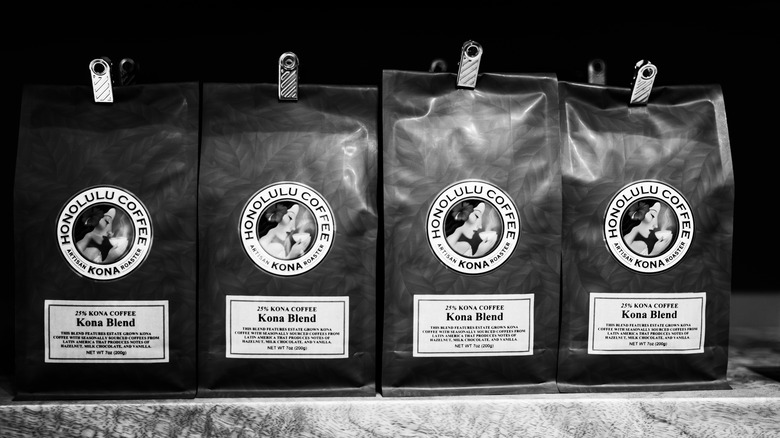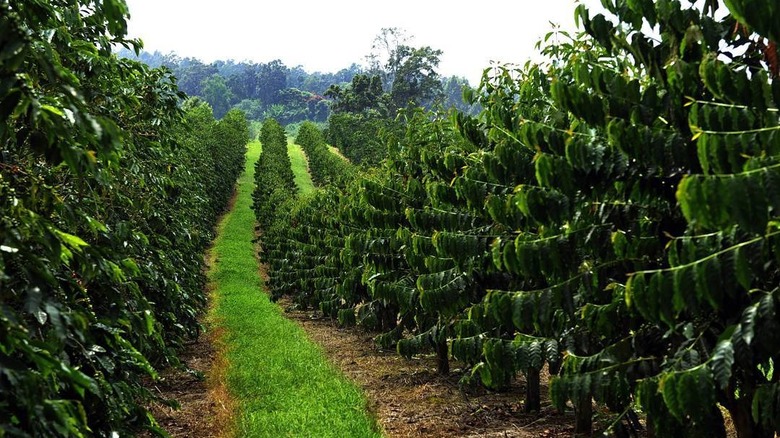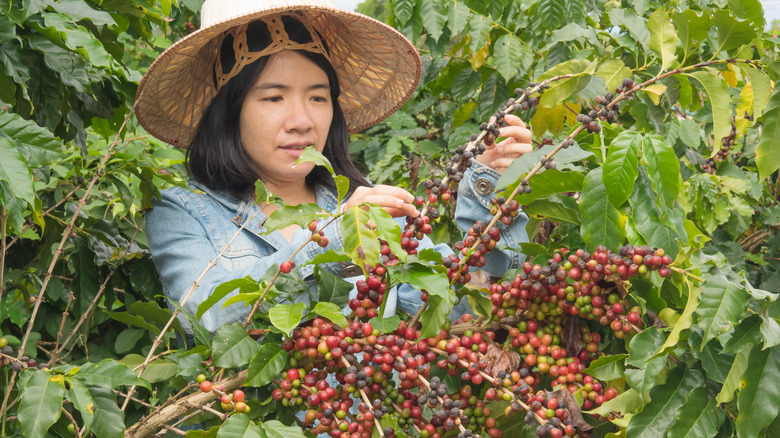The Real Reason Kona Coffee Is So Expensive
Whether you're a fancy coffee aficionado or a gas station guzzler, you probably remember the first time you drink a cup of Kona coffee. Its sweet, smooth flavor with warm notes of spice and nuts — and not a hint of bitterness to be found — is a rare beauty when it comes to java. For those of us who appreciate good coffee in addition to needing it for basic functions, Kona coffee is a real treat that makes others pale in comparison.
According to Full Coffee Roast, Kona beans release flavors that create a very unique cup of coffee, depending on the roast level. Light-roasted Kona coffee is medium-bodied with a vibrant yet balanced acidity that awakens the palate with its fruity undertones. Darker roasts bring out the nutty and buttery caramel notes that will have you asking for a refill. Flavor profiles like these make it obvious why Kona is a favorite in the coffee world, but, like most popular things, it comes with a hefty price tag. So, why is it so expensive?
Kona coffee is produced in small amounts but is highly desired
Kona coffee is made in the USA, and is grown mainly along the western coast of the Big Island of Hawaii. In fact, Kona coffee beans are one of the only types grown in the United States, according to Kona Mountain Coffee, and this temperamental tree only produces 1% of the world's coffee supply, though it is recognized worldwide. The availability and demand for this delicious cup of joe partly explains why Kona coffee is so pricey — as are environmental issues currently affecting its growth.
The mainland U.S. doesn't have many regions that lend themselves to producing coffee beans, but there is ideal climate and terrain converging around the Hualalai and Mauna Loa volcanoes in Hawaii that make it fertile territory. Kona Coffee says that this nutrient-rich volcanic soil is complemented by sunny mornings, cloudy and wet afternoons, and mild nights that create the perfect environment for the finicky tree on which these beans grow.
Though, currently this small 30-mile stretch of land that boasts Kona coffee crops is being threatened by invasive plant diseases and an infestation of beetles called coffee cherry borers that have ruined acres of trees and devastated many coffee plantations in the tiny region, forcing some to supplement their coffee with a blend of other bean varieties, adds Kona Coffee. Coffee leaf rust is a plant disease that has also invaded many coffee farms and sent farmers and agriculture officials scrambling to protect their coffee trees. Infestation and disease have decreased the already limited amount of Kona coffee available and have further made prices skyrocket.
Harvesting Kona coffee is expensive, too
Most countries that grow coffee harvest their beans with machines, but the rocky terrain of the volcanic slopes in Hawaii where Kona beans are grown requires highly labor-intensive hand-picking. Coffee farmers in Hawaii are paid minimum wage, which increases the labor cost to harvest Kona coffee compared to the inequitable wages allowed in other countries (via Buddha's Cup). Though, it's a small price to pay when considering the hard work that coffee farmers put forth and the need to earn a livable wage.
Hand-picking these beans is also directly related to the noticeably higher quality flavor of Kona coffee. When harvested mechanically, coffee trees are shaken and drop beans ranging in different sizes and degrees of ripeness (per Coffee Masters). Small unripened beans are often the culprit of the characteristic bitter flavor of coffee that starts your day off wrong. Instead, coffee farmers pick Kona coffee beans from the same tree multiple times to ensure that they are selecting the perfectly ripe, big red beans that will yield an unforgettable cup.
Kona coffee's small growing region, limited availability, and costly farming methods contribute to its surprising price tag. When you take that first eyebrow-raising sip of smooth coffee goodness, though, you will likely agree that it's worth every penny.


